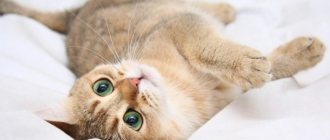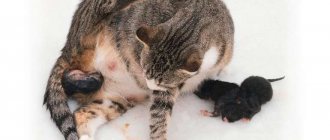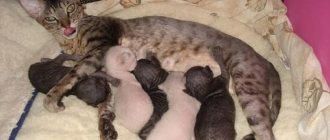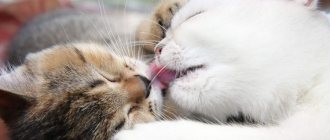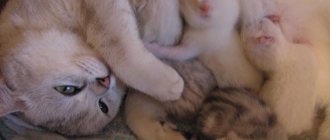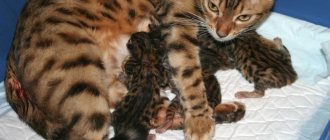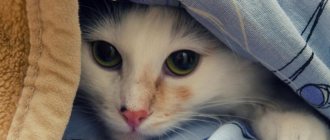Stages of pregnancy and childbirth in cats.
On average, pregnancy in cats lasts 60-63 days.
A deviation from this figure by a week, up or down, is normal. In the last week, changes such as a hanging belly, enlargement and softening of the vulva, swollen nipples, and enlarged mammary glands become noticeable. Loss of appetite and nervousness, alternating with drowsiness, also indicate impending labor. To answer the question how long does labor last in cats?
, you need to understand what we are talking about. Childbirth in cats consists of three stages, each of which takes a certain time.
At the first stage
, the cervix dilates and relaxes. Before giving birth, a cat changes its behavior, for example, it may make frequent trips to the litter tray (which needs to be moved as close as possible). Often the cat begins to “put things in order” in the box prepared for childbirth, digging up and moving the prepared bedding in it, intensively licking the mammary glands and the perineal area. Some cats are wary, restless, and try to hide, so the box should be located in a quiet place. To calm your cat, you can dim the lights, sometimes this helps. The first stage can take from 12 hours to a day.
Second stage of labor
begins when the first kitten passes into the pelvic canal. A cat is capable of delaying birth if it finds itself in an unfamiliar place or sees strangers or animals around it. She can increase the interval between the birth of kittens to several hours if she feels pain during the birth process. During labor, your cat may meow, scream, and pant.
At the second stage, active pushing out of the first kitten begins. The first kitten takes longer to be born than the others, as it has to pass through an incompletely dilated cervix. A cat can give birth standing, lying and squatting. The abdominal muscles are involved in the process. Usually the kitten appears within 15-30 minutes from the start of contractions, with three to five contractions per kitten considered normal.
First, a bubble containing amniotic fluid (amniotic fluid) becomes visible. The kitten can sit forward in it with both its head and legs - both positions are considered normal. As soon as the kitten is born, the cat must remove the bubble film from its face. She licks the kitten and herself. By licking the kitten, the cat stimulates its independent breathing and movement. The kitten should begin to breathe and move in the first seconds of life. The cat gnaws the umbilical cord at a distance of 3-5 centimeters from the kitten’s body. If she does not do this, you need to place clamps on the umbilical cord one and a half centimeters from the kitten’s body and cut it between the clamps. If the umbilical cord is bleeding, it needs to be bandaged. The umbilical cord should not get tangled around the legs, as if it dries, it can pull on the paw, which can even lead to the kitten losing a leg. The placenta and umbilical cord should be removed from the box if the cat does not eat them (usually the cat will eat them). If the kitten is not breathing, turn it upside down to allow fluid to drain from the lungs and nasal passages.
Kittens that have had a difficult birth may be weak or not breathing when finally born. In this case, a syringe is used to clean the airways (of course, without a needle)
Some breeders swing the kitten upside down between their own legs, but this must be done very carefully so as not to drop it. The pressure created by rocking helps clear the airways of fluid, but at the same time, the kitten's brain also swings inside the skull.
When the liquid has drained, the kitten is rubbed with force, but carefully, with a cloth to stimulate spontaneous breathing. Artificial respiration is done for five minutes until the kitten begins to breathe on its own. For some kittens, especially those born by Caesarean section, veterinarians will work for up to 20 minutes to keep them alive. As soon as the kitten begins to squeak and move, the immediate danger can be considered eliminated.
From this moment on, the kittens can be placed with the cat. The cat will lick the kittens while continuing to stimulate their breathing.
Kittens may immediately begin trying to attach themselves to their mother, or they may begin to do so within a few minutes. Some cats don't nurse their kittens until they've given birth to all of them.
Third stage
- release from the placenta.
How to distinguish normality from pathology, and how to help your cat
Normally, the most important part of childbirth occurs as follows: the kitten emerges from the birth canal head first, in the amniotic sac, which ruptures on its own or is ruptured by the cat. After this, the mother intensively licks the baby, clearing it of any remaining amniotic fluid, gnaws the umbilical cord, eats the afterbirth that follows the kitten, and places the baby closer to the stomach so that it begins to suck colostrum. The birth of one baby takes about 15 minutes.
If everything happens this way, the newborns begin to squeak, move and suck milk, and the cat looks normal, the owner can only count the cubs and the placenta - they need to be equal in number (the placenta remaining in the uterus can cause an inflammatory process and other complications). Help for a giving birth cat is only necessary for complications, which can be mild or severe - in the first case, the owner of the animal can cope on his own, and in the second, the help of an experienced veterinarian is required.
We invite you to read: Sturgeon breeding: business plan
At the beginning of labor, the cat requires practically no assistance - the owner can talk gently to the woman in labor, and also lightly stroke her back and stomach. This will calm the animal and at the same time stimulate labor. For individuals with long hair, you can loosely wrap a piece of gauze around the base of the tail so that the kittens do not get confused, and it is easier to control the process. If the female becomes restless or aggressive, it is better to leave her alone and watch the birth from the side.
The following stages of lambing are distinguished:
- First stage. Characterized by an increase in pain. Bloody excreta appears from the swollen vulva. Contractions begin. The duration of stage I is 12…24 hours.
- The second stage is the birth of the first kitten. An amniotic sac (bubble) appears. Liquid flows out of it, the cub moves forward with its head or hind legs. The cat frees its cub from the bladder, licks it, bites the umbilical cord. The kitten takes its first breath, accompanied by meowing. The mother applies it to the nipple and eats the afterbirth.
- The third phase is manifested by a temporary cessation of contractions after the release of each kitten and placenta. It is not recommended to let your cat eat more than two placentas. After 10...15 minutes, new attempts and the birth of the next one follow.
The cat releases the kitten from the amniotic sac. It is necessary to count the released placenta. Their number should be equal to the number of kittens born. If any of the placentas do not come out, you need to contact your veterinarian. In total, the second and third stages of labor last 2...6 hours, with an average of 3...5 kittens being born.
Delayed birth is considered a variant of the norm. The cat is busy with the kitten, and suddenly, after 1/2…3/2 days, labor resumes.
The amniotic sac comes out
( 2 ratings, average 4.5 out of 5 )
This is interesting: Cat behavior before giving birth
What does (low) multiple pregnancy depend on?
Young cats give birth to 1 to 3 kittens for the first time.
There are both a huge number of hypotheses and scientifically proven facts on this matter. Our topic is not a dissertation for an academic degree, so we will lump all theories and evidence into one common pile.
Proper and nutritious nutrition has an important influence on conception, subsequent pregnancy and childbirth: the worse a cat eats, the less likely it is to become pregnant. There is such a thing as nutritional infertility - in this way nature tries to prevent the appearance of non-viable or sick offspring. The weight of the pet also plays an important role in the production of eggs and subsequent pregnancy.
It is well known that obese females not only do not become pregnant, but they, in principle, do not go into estrus - what kind of multiple pregnancy can we even talk about in this case? Conditions of keeping: comfort, warmth, cleanliness, lack of stress, etc. Hereditary factor: if a cat was born from a low-fertility mother, then the likelihood that she will produce “a little” kittens is very high! A history of infectious diseases that somehow affect the development of reproductive function. Diseases of the reproductive system and injuries also affect the number of eggs produced. The temperament of a cat, no matter how strange it may sound. After all, it is well known that ovulation in cats occurs at the moment of coitus, and the sexier the male is, the more he cares for the bride, the more eggs will be released. Incompatibility with the opposite sex, which also occurs in humans. So, for example, there lived an allegedly infertile cat who was in heat, and they bred her with three different cats, but there was no effect. Until her permanent fiancé appeared in her living space. Apparently, the every minute presence of the cat, its smell, awakened hidden possibilities in the “woman’s” body. Let’s remember once again about cats, or more precisely about the quality of their sperm. The weaker the sperm, the smaller their number, the more underdeveloped among them, the less the chance of getting healthy, and most importantly, multiple offspring from a healthy cat. In turn, the quality of sperm depends on the nutrition of the reproductive system and the frequency of its use (both excessive use and abstinence have a negative impact on reproductive function). Low hormonal levels of the expectant mother, when the follicles produce few eggs ready for fertilization. Long-term use of antisex hormones will not only affect the number of offspring, but also its viability. Most often, a cat mated after such therapy brings 1-2 kittens, while they are weak or not at all capable of life outside the womb. Individual characteristics of the body, size, weight, age, etc., etc. Breed is another factor. For example, outbred cats can give birth to many kittens in the first, subsequent, and very last pregnancies. Whereas animals of blue blood rarely bring more than 5. It is believed that the number of matings affects the number of kittens. Allegedly, after the first mating, the animal brings 1-2 kittens, by the seventh it reaches its natural maximum, and after that the number of offspring decreases again. Another theory, more like nonsense, says: the sooner insemination occurs from the start of estrus, the more kittens will be born.
Factors influencing development
The development of cats is influenced by the following internal and external factors:
- Floor. The male develops faster, grows larger and 2-3 kg heavier. Already at 3 months, boys are much heavier than girls.
- Mother's sizes. The larger the female, the faster the kittens grow in size.
- Genetic factors. Breeders note that kittens from the same litter develop at different rates. However, if you want to know how big your pet will grow, you need to look at the parents, or better yet, at the grandparents, if possible.
- Stress. The development of a kitten, especially when it has just arrived in the house, is affected by the stress of moving, a new environment, and a different diet. During this time, your pet may lose weight.
- Balanced kicking. Feeding a pregnant cat and her babies is also important.
- Conditions for physical exercise. Maine cats need exercise to develop and grow.
- Presence of diseases. Diseases suffered during a period of active growth, taking medications, especially antibiotics and hormones - all this can slow down development. For these reasons, there are cases when the size of an adult Maine Coon differs little from that of an ordinary cat.
How to increase your cat's fertility
When raising purebred cats, the question of increasing the birth rate often arises. It is possible to design the scale of offspring in advance using special medications and homeopathic remedies. Hormonal substances should be given in moderation and under the supervision of a veterinarian. In homeopathy, ovariovit and gamavit have proven themselves well. Vitamin E and selenium, in small doses, have a positive effect on the cat's reproductive activity.
The birth of kittens is a complex physiological process. In it, the quality and health of the babies is more important than the quantity of the offspring. Owners should support their pets and provide assistance to them, especially if a cat gives birth for the first time.
How to weigh a kitten correctly
If the kitten is very small, then in order to weigh it, you can use a regular kitchen scale and a small box. To prevent the kitten from turning weighing into a game, the best time for the process is immediately after sleep. If the baby starts spinning and jumping, the indicators will be inaccurate. Trying to hold a playful baby with your hand can also get a distorted result.
To get the most accurate figure for the baby’s weight, you can follow two methods:
- First, weigh the box, then put the kitten in it and record the result again. Subtract the difference.
- Place the box on the scales, and only then turn them on. They will show zeros. After this, we put the baby in a box and get the figure for his body weight.
It is more convenient to weigh mobile kittens in small containers or boxes to get a more accurate result.
This way the owner will receive an exact figure in grams, which can be entered into the animal’s weight diary.
Video: how to weigh a cat
How many kittens can a cat give birth to for the first time?
Someone tell me how many kittens a cat giving birth for the first time can give birth to. My cat only has two towers. Say it's not enough for the first time or just right. and how long she will give birth later. Is there a pattern?
For the first time this is quite a good number. Our Cat had four kittens in her first litter and it was a little hard for her, you could feel it. And so there is no special pattern in the number of kittens in the litter from time to time, at least we did not observe it. Another thing is the frequency of lambing per year; over time, it may turn out that the cat will give birth more than once a year, but, fortunately, not every year.
I think there is no pattern as such. My previous cat gave birth to 5-6 kittens from the very beginning, and the other one gave birth to two or five. As for you, I think everything is normal that the cat gave birth to two. It’s easier for her will provide food, because the cat itself is young. The main thing is that the cat has a good character, that she is normal, like her mother. Otherwise, she gives birth and doesn’t look after them. The babies scream, and she basks in the sun, and nothing else is needed. Eat and go to the sun!
There is no particular pattern in the birth of kittens. A young cat can give birth to one to four kittens. An older cat will please from six to twelve kittens. The health status of your ward also plays a role in the number of fruits produced. A healthy cat, with a good diet, is able to bear and give birth to more healthy babies. Heredity also plays a role. A cat born in multiple litters has a greater chance of producing more kittens.
No, there is no such pattern. It all depends on your cat's predisposition. Pedigree cats usually give birth to fewer kittens; young and old cats give birth less, as well as cats whose kittens are born large. There is absolutely no way to guess or calculate in this matter; next time she may give birth the same amount, or maybe less, or more. You don’t say what breed she is, if she is purebred, then this is a normal amount for the first time. Now many breeders use special supplements and vitamins to increase the number of offspring, but I do not recommend this. It is unknown how they affect kittens. It’s better to have fewer, but healthy, babies born.
Stages of kitten development by month
The stages of growth and maturation of a kitten, from the moment of birth to one year, are associated with certain patterns. All kittens go through the same stages of development over the course of days and months.
First week
Kittens are born with their eyes closed and hear almost nothing. They are covered with light fluff; the most important thing for them during this period is warmth and milk.
In the first weeks, kittens' immune systems are largely supported by mother's milk. It provides their body with the proteins necessary for development. The weight of newborn kittens rarely exceeds 100 grams; within a week they gain weight from 10 to 30 grams per day.
Most of the day, approximately 90% of the time, kittens sleep. They move only to crawl to the cat for milk and warmth. If they are cold or want to eat, they call the cat with a loud squeak.
Observing the development of small kittens day by day, it can be noted that on days 5-8 kittens develop hearing. Since kittens are just learning to respond to sound, the room where they are should be relatively quiet.
After the 5th day of life, the umbilical cord dries out in kittens. The cat should constantly lick the cubs, giving a tummy massage, which helps stimulate the intestines.
There should be no drafts in the room where the cat and newborn kittens are located. If it is very cold, you can put a heating pad in the bed. Young kittens are very vulnerable to disease and infection.
Second and third weeks
On days 7-10, the eyes open. The process can take 2-3 days - at first there are narrow slits through which only the outlines of objects can be distinguished. The eyes are cloudy, blue and covered with a film. The eyes open completely by the 14th day.
The speed of eye opening depends on several factors:
- by breed;
- from gestation period;
- on the health status of the mother and kittens.
In most cases, short-haired breeds develop faster than long-haired ones, and Oriental cats develop much faster than other cat breeds. For example, sphinxes (Canadian, Don) are often born with their eyes already slightly open, and on the 2-3rd day the eyes open completely. Siamese, Thai and Cornish Rex cats become sighted on days 3-6, Siberian and Persian cats on days 5-9, and British cats on days 6-10.
Another indicator is the gestation period of the kittens. If kittens are born at 68-71 days, then perhaps they will be born with their eyes already open, or will open them in a much shorter time.
If the kittens are healthy, eat well, and the cat devotes enough time to them, then the eyes, as a rule, open in a timely manner. A delay may indicate that the mother cat has some kind of virus, or that the kitten has developmental disorders. If more than 10 days have passed and the eyes are still closed and there is some discharge from under the eyelids, you need to consult a veterinarian.
In 2-week-old kittens, the fur grows and becomes thicker, and the undercoat begins to grow. At this age, kittens' susceptibility to temperature changes decreases, however, they are still vulnerable. The kittens' weight doubles. They hear much better, but still have difficulty identifying the source of sound.
A kitten at the age of 3 weeks continues to actively gain weight; its vision is not yet so sharp, so when it crawls, it can bump into objects. In the third week, the kittens make their first attempts to get out of the bed. During this period, baby teeth begin to emerge.
Kitten at 1 month
At 4 weeks of age, kittens begin to interact more and lick each other's fur. They begin to actively run, play, and adopt the skills of their mother. At this time, you can place a tray next to the bed on which the kittens sleep so that they begin to get used to it.
By the age of one month, the kitten has 26 milk teeth and sometimes bites the cat's nipple, causing pain. If maternal feeding stops by the age of one month, it is advisable to purchase a cat's milk substitute, since the kitten's body is not yet fully formed. At this stage, complementary foods and clean water are also introduced into the diet.
The bones of one-month-old kittens become stronger, they can already be picked up, stroked and played with more often so that they begin to get used to the person and his smell. This is also a good time to prevent worms.
By the age of one and a half months, the kitten already knows how to wash itself, hunt, go to the litter box, and eat solid food. At this time, you can purchase a scratching post, as the kitten begins to produce sharp claws.
Kitten at 2 months
Upon reaching the age of 2 months, kittens usually stop receiving mother's milk and switch to self-feeding.
At 2 months, kittens’ vision is fully formed, hearing and sense of smell are well developed. The kittens' eyes cease to be cloudy and acquire their natural shade. However, there are specific breeds in which the eye color does not change, for example, Siamese, Thai, Polynesian and British breeds.
The fur changes color intensity, the pattern appears, the lines become clear. This happens slowly and gradually, and therefore is not immediately noticed by others.
During this period, the kitten should be shown to a veterinarian for the first time, who will record the level of development and health status of the animal. At the age of 2.5 months, the kitten must receive its first vaccinations against viral diseases. The second vaccination is given after 3-4 weeks.
Kitten at 3 months
In the third month of life, all processes begin to slow down a little, and the kitten’s character begins to emerge. He becomes completely independent and responds to his nickname.
A three-month-old kitten has a well-developed musculoskeletal system; he already knows where the bowl is and where the tray is. At this age, the kitten becomes faster and bolder. He is actively exploring his home, so it is necessary to ensure his complete safety. You should protect the kitten from chemicals, detergents, medications, poisonous plants, remove small objects - needles, pins, push pins, close electrical outlets.
A booster vaccination can be given at 12 weeks of age. At this time, it is also necessary to carry out repeated deworming, provided that it was first carried out at the age of 4-6 weeks.
By 3.5 months, the kitten’s character has already been formed, it sees and hears excellently, eats natural or industrial ready-made food, and goes to the litter tray. You can already visually distinguish a cat from a cat.
If you plan to give away or sell a kitten, then the age of 3-3.5 months is an ideal option for changing the owner.
Kitten at 4 months
At 4 months, a kitten is already considered a teenager. During this period, his claws are trimmed for the first time and he is taught all hygiene procedures. To maintain proper development, you need to spend as much time as possible playing with the kitten; it is recommended to pick it up more often, show care and groom it daily so that the kitten feels comfortable when communicating with a person.
Milk teeth in kittens begin to change to molars; this happens gradually and often unnoticed by the owner. Kittens swallow most of their baby teeth with food.
Kitten at 5 months
At 5 months, the kitten’s appearance gradually changes, its body increases in size, its muzzle and tail lengthen, its legs stretch. He already looks more like an adult cat, he is less interested in toys, he sleeps more and strives to communicate with people.
Sixth month of life
At the age of 6 months, the kitten reaches its adult size. Most kittens begin puberty during this period. The timing of puberty can shift from 4-5 months to 11-12 months of age. Puberty is affected by:
- Breed. Siamese, Thai, Burmese, and Oriental varieties ripen earlier.
- Season. In cats that reach 4-6 years of age in the spring and summer, puberty occurs earlier than in cats of the same age in the winter months.
- Maintenance and nutrition. Comfortable conditions and regular nutritious food help the pet mature faster.
- Habitat. Cats living with other adults of both sexes mature earlier than cats living in a city apartment.
When a kitten reaches puberty, hormones change its behavior. The cats behave restlessly and rush around the apartment. Cats may become more aggressive. For this reason, it is important to consider spaying and neutering cats.
If offspring are undesirable, then girls should be sterilized at 6-8 months, boys should be castrated at the age of six months to a year. After the operation, the kitten’s body produces fewer sex hormones, and the animal loses the ability to reproduce.
If you decide to get offspring, then you should remember that physical and puberty are not the same thing. Regardless of the timing of puberty, the kitten’s physical maturity occurs no later than 10-12 months of age. It is during this period that you need to plan your first mating.
Kittens at 7-8 months
At 7 months, in autumn-winter, kittens begin their first molt. Because kittens lick themselves frequently during shedding, a large amount of hair accumulates in their stomach. To prevent this process, it is enough to regularly comb the coat with a soft brush.
From the age of 8 months, kittens practically do not gain weight, their growth does not noticeably increase. They have established habits. The characteristics of temperament are clearly visible.
Development from 9 months to 1 year
At 9 months, the kitten is fully formed, its development is almost complete, and it continues to grow into an adult, increasing in size and gaining weight. By this time, the regime has stabilized, the pet finds time to sleep and play.
At 10 months, a kitten is considered sexually mature. But mating before a year should not be carried out. The size of the cat at this time is already significantly larger than the size of the cat; these differences can be more than 1 kg.
At 11 months, most kittens stop growing. At 12 months, the kitten already looks like an adult animal. By this time, it is necessary to complete all vaccinations during the first year of life, castrate or sterilize, and switch to food for adult animals.
Problems during childbirth that you can solve on your own
As soon as the second, most important phase of childbirth begins, the cat’s owner must be nearby at all times in order to notice possible pathologies in time and provide assistance to the animal. With regular contractions, you can give an injection of calcium gluconate (1 ml) at 3-4 different points on the cat’s body, and another injection after birth - this will help the cat endure contractions more easily and prevent eclampsia. The need to administer other drugs (Travmatin, Gamavit, etc.) depends on the condition of the animal, the presence or absence of problems during the delivery process.
Help for a giving birth cat is only necessary if there are complications.
What to do, if:
The kitten is stuck in the genital tract and comes out with its back or tail first. This happens when the fetus is malpresented or in situations where the kitten is quite large. If left to chance, the baby may suffocate in the birth canal, so the owner needs to put on disposable gloves, lubricate his fingertips with Vaseline and carefully pull him out. It is better to pull not by the paws (there is a high risk of breaking or damaging them), but by the skin on the withers, grabbing it with three fingers. The amniotic sac did not rupture. In such cases, the cat must rupture the membrane of the amniotic sac itself, but sometimes it cannot perform its functions due to inexperience or weakness, and then the “obstetrician” must release the kitten
The bubble should be broken close to the baby's nose, being extremely careful not to scratch its delicate skin. The cat did not bite the umbilical cord. Females do not bite the umbilical cord immediately - usually after the baby is completely cleansed of tissue and water residues
If this does not happen 15-20 minutes after the baby comes out, you need to cut it yourself. To do this, the umbilical cord is tied with a clean thread, 4-5 cm away from the kitten’s body, after which it is cut from the side of its abdomen next to the constriction. After completing the procedure, you should make sure that the cat begins to lick the incision site - if she refuses to do this, you need to cauterize it with an antiseptic.
Females do not immediately bite the umbilical cord
The cat does not care for newborns. Licking kittens immediately after their birth is necessary not for reasons of hygiene, but for the start of normal life of the offspring. If the cat has not started grooming the kitten, you need to rupture the amniotic sac, cut the umbilical cord, then wipe the baby with a clean cloth and use a syringe to remove mucus from the nose and mouth. Next, it is advisable to place it on the cat’s nipples - it will begin to drink colostrum, massaging the stomach and nipples with its paws, and the whole process will go faster. The kitten is breathing unevenly or not breathing at all. Most often this happens in cases where he inhales a certain amount of amniotic fluid.
The kitten should be picked up, held head down for a few seconds and gently shaken - after which it should squeak. To make sure that the baby is in normal condition, you can examine his tongue - it should be pink, which indicates normal saturation of the body with oxygen.
The kitten should be picked up and its viability checked
The placenta does not come out of the uterus. If at least one placenta remains in the genital tract and does not come out approximately an hour after the birth of all kittens, you need to carefully pull it out by wrapping your fingers in a clean bandage.
After all the kittens have been born, you need to remove all garbage and dirty diapers, cover the box with clean bedding if necessary, and make sure that all the babies have access to their mother's milk and are sufficiently active. If the cat is in no hurry to show maternal instinct, runs away from the kittens, does not want or for some reason cannot feed them, you should buy a special milk formula and a feeding device (sold in veterinary pharmacies).
After giving birth, you need to make sure that the cat and kittens are healthy
How to feed a newborn kitten if the mother cat refuses to do so
How does the number of kittens affect the health of the mother?
In fact, not all breeders welcome multiple pregnancies. This is due to possible risks and the same financial losses:
- some kittens may be born weak and non-viable;
- there is a high probability of complications of the birth process, which will result in the complete removal of the uterus and appendages;
- Even if the kittens are born healthy and vigorous, it will be difficult for the mother to feed them on her own, and she will have to spend money on expensive artificial nutrition, get up at night and look after the babies.
At the same time, a low-fertility pregnancy is fraught with problems:
- a fetus that is too large may get stuck in the birth canal and require a caesarean section;
- Excess milk will cause mastitis.
Summarizing what was written above, I would like to say that a lot depends on the breed, physical characteristics, health of the expectant mother and... the theory of probability or lady luck!
How many kittens can a cat give birth to?
Now let's move on to the most interesting part: how many kittens can a cat give birth to at most? Let's talk about several features that affect the number of newborns.
Cat's age and birth by count
If pregnancy and childbirth are the first, the cat is young, then the likelihood is that there will be from one to three kittens in the litter. With each subsequent pregnancy, the number of newborn mustaches will increase (from three to eight on average). But an elderly cat also does not bear large offspring. Still, it’s already hard, there’s not enough strength, they may be born dead or non-viable. “Extra” embryos, which the mother cat may not tolerate or feed, are resorbed even in the early stages of pregnancy. Even if a cat was able to give birth to six or eight, it is not a fact that all of them will survive. It’s not uncommon for a couple of these babies to die without even surviving a week.
Genetics
No matter how funny it may sound, a lot depends on how “fertile” your cat’s mother was. If she gave birth to many babies at a time, then your pet will most likely bring the same amount. And if one or two kittens were born in a family at a time, then your cat will probably give birth to a small number.
Health
If cats are poorly fed, lacking vitamins and minerals, then in most cases they give birth to no more than three kittens at a time. Weakened pets are not able to normally bear viable offspring.
Breed
It has long been noted that outbred cats are capable of giving birth to up to eight kittens at a time, but purebred cats, on the contrary, are not distinguished by their fertility. However, there is a known case when one Persian cat gave birth to 15 little kittens! So if you are wondering how many kittens a cat can give birth to at most, then their number can reach 14-15 pieces, but this is very rare.
Cat
Not everything depends on the expectant mother. The “father” also influences a lot.
- The health of the cat (does it have any infectious or inflammatory diseases, especially of the genitourinary system),
- age (too young and old will not be able to boast),
- the number and frequency of matings (the more there are, the worse the quality of the sperm, and, therefore, the number of kittens decreases, and their health will be worse),
- cat's nutritional conditions,
- was the cat cryptorchid, etc.
Is it possible to influence the number of kittens?
To increase a cat's fertility, there are special treatment regimens.
This question is usually asked by cat breeders who sell kittens. After all, not only the expected profit directly depends on the number of offspring, but also covering the financial resources that were spent on mating with a good sire, tests, treatment, nurturing and feeding the future “money bag”.
Depending on the regalia of the male, the cost of mating can reach 10 thousand rubles. In most cases, owners of inseminators do not try to in any way influence the male health of their charges. Like we get money for mating, and then your problems: whether you got pregnant or not, how many kittens were born - it doesn’t concern us. This attitude is fundamentally wrong, and both sides should be interested in the offspring. Therefore, before you give money, ask:
- how often is a cat used for mating;
- is he eating well?
- does he have any diseases of the genitourinary system;
- how many kittens other cats bring from him;
- Does he suffer from cryptorchidism?
To increase fertility, many professionals advise injecting cats with:
- Ovariovit is a homeopathic drug, its action is aimed at restoring ovarian function, regulating the reproductive cycle and increasing fertility;
- Gamavit is an anti-stress, immunostimulating drug that supports the vitality of the body, and has a positive effect on eggs;
- Vitamin E – prevents infertility, has a positive effect on the reproductive system.
There is even a special scheme designed for 10 days:
- Ovarium (stimulates the protective function of the reproductive system) - half a cube is administered subcutaneously once a day;
- Ortilin (reduces the risk of inflammatory processes in the uterus) – one tablet twice;
- Ovariovit one tablet twice;
- vitamin E capsule twice a day;
- Gamavit one cube a day subcutaneously;
- Catozal (to normalize metabolism, increase immunity, resistance to stress) one cube per day subcutaneously.
Before putting any regimen into practice, consult your veterinarian!
Why does this work?
- Treatment may worsen estrus symptoms and increase hormone levels.
- At the same time, the cat becomes more attractive to the inseminator and is ready to attack the future father.
By the way, you can “stimulate” the cat by injecting him with B vitamins a couple of days before mating, which have a beneficial effect on the body’s endurance and activity.
Regarding the opposite effect (low fertility), there are no proven schemes as such. For example, there is an opinion that if after giving birth a cat with multiple births is left with only two kittens, then a certain switch is triggered in the body and the next time the animal will bring exactly two kittens. Although in practice, I personally have never observed such a phenomenon.
You can also do the opposite:
- poorly fed;
- keep under stress;
- exploit more often, forcing her to become pregnant every time she is in heat;
- periodically use hormones that inhibit the functioning of follicles.
In such living conditions, the body will quickly become exhausted and the cat will definitely stop giving birth a lot, if at all.
Signs of unfinished labor
Before taking action, you need to check whether the cat can give birth to not all kittens at once. The situation can be found out by observing it. Signs that not all kittens have been born include the following:
mom lies on her side without changing position
There is little or no interest in children; the cat does not want to eat or drink; when observing an animal, you can periodically see how attempts occur; if you carefully palpate the tummy, you can feel a strong muscle tone; the mother has had a fever for a long time; Blood discharge is noticed from the uterus, during which an unpleasant odor can be felt.
Important! If there is an assumption that not all babies were born, it is necessary to call a specialist as soon as possible and send the cat to a veterinary clinic. In such cases, an ultrasound examination is performed to clarify the clinical picture and measures are taken according to the situation.
Bleeding may mean labor is not over
How does childbirth take place and how many hours?
In order for your cat to lamb without complications and for all the kittens to be alive and healthy, you need to help your pet.
Every pet owner should provide assistance correctly and efficiently, and know the main stages and features of childbirth.
To cope with childbirth in a cat, it is enough to familiarize yourself with the process using special literature.
If an animal develops complications before or during birth, you should definitely call a veterinarian.
How does childbirth occur in a cat?
- The first stage is determined by the beginning. Contractions can be determined in accordance with the behavior of the animal. The female begins to look for a suitable place, constantly hangs around the owners and becomes noticeably nervous, experiencing painful sensations.
- After the end of the first stage, which lasts from 12 to 24 hours, the time comes for the second. At this moment the attempts begin. The cat no longer moves, the amniotic fluid is leaking. At this moment, it is advisable to stay near the pet for as long as possible.
- The cat does not need help during the birth process. It is enough to accept the kittens and lay them down so that the new mother cannot crush or injure the babies. If the kitten walks not with its head, but with its legs forward, then the animal needs help: slightly pull the kitten by the paw forward, and then down.
Lambing will end in about 1-3 hours. The young mother will begin to lick and feed her offspring. To prevent the animal from getting up again, you need to place food and drink nearby.
For the first 3 days, it is worth closely monitoring the health of the female and the offspring. During this time, problems or pathologies will appear that may affect the further quality of life.
Useful video
- Related Posts
- Zircon: plant growth stimulator, application
- Reasons why a dog’s mouth stinks of rotten meat, and what to do about the unpleasant odor
- What Indian, Russian or teen movie should I watch when I want to cry?
- How to make liquid soap from soap remnants with your own hands: a simple method
- How to quickly paint moonshine so that there is no smell: a simple method
- Benefits and harms of safflower oil: composition, use in medicine, cosmetology and cooking
- Materinstvo.Info: 09.15.2018 at 02:11
The article contains all the necessary information for the owner of the animal, supported by a photo in order to learn how to distinguish a cat from a cat. It will also be useful to learn how to properly feed a kitten at 10-12 weeks.Answer
How often can you give birth?
A sensitive issue that worries good owners concerns how often a cat can give birth. There are several opinions that differ significantly.
Note! When making a decision, it is worth considering the cat's health characteristics.
Veterinarians and professional breeders of certain breeds give different recommendations regarding the frequency of lambing.
Fans adhere to completely different norms, dosing cats with hormonal pills at the time of estrus to stop the process.
How often can a cat give birth:
| Who makes the recommendation regarding the issue? | Top advice regarding lambing |
| Experienced cat breeders | It is recommended to breed a female according to the plan. Typically lambing is planned once a year. It is believed that the female’s body is in harmony and the quality of the litter will be much better |
| Experienced hosts | They say that it is enough for a cat to give birth 2 times a year. This will allow you not to overstrain your body and keep it in good shape. Otherwise, the animal begins to get sick often and behave inappropriately. |
| Veterinarians | Catch a cat when it comes into heat. Therefore, births may not be limited to 3-4 in 1 year. If the animal's needs are ignored, health problems may arise, leading to infertility and even death. |
Harbingers of childbirth
A few days before the start of the long-awaited event, many owners note a change in their pet’s behavior:
- 2-3 days before birth, the external genitalia swell slightly and turn pink. The cat begins to carefully lick its belly and wash itself.
- Decreased activity - becomes detached, apathetic.
- Lack of appetite. Often within a day or so, most cats will refuse to eat. There is no need to insist, they themselves know how it will be better for them. But you need to take care of fresh drinking water.
- A few hours before the onset of labor, the female begins to experience training contractions of the uterus, and the animal begins to instinctively arch its back. Having noticed such manifestations, you need to limit the cat’s movement, transfer it to a prepared box and stay nearby while awaiting birth. Otherwise, being frightened, she may hide in a hard-to-reach place.
- The cat begins to follow the owner and meow pitifully. This behavior indicates the imminent onset of labor. With this cry she is trying to ask for help and support from people. You need to calm her down, pet her and be nearby in case she or the kittens need help.
- The amniotic fluid begins to recede, but the owner may not notice this, since the cat can lick it off.
Search for a place
A place for a woman in labor can be arranged on a bed or using a tray. The most suitable option is a cardboard box, the bottom of which is covered with paper. Qualities that a birthing place must meet:
- The box should be closed, but large in size, since the animal will live there with the kittens for several months.
- For convenience, one wall of the box is cut off. This will allow the cat to freely enter the bed area without jumping over the barrier each time.
- The prepared house is installed in a quiet place, closed from prying eyes. This could be the bathroom, a corner of the room behind the sofa, or a closet.
If the cat ignored the chosen place and hid in the closet, this is an indicator that it lacks silence and feels unprotected.
Postpartum period
The absence of contractions for 2 hours and the prolapse of the abdomen indicates the completion of the birth process. The behavior of the female also changes: she calms down, her breathing evens out, she lies down more comfortably in the box, and continues to lick and feed the babies. You should not give food to a woman in labor immediately after birth, but you can offer water or milk. She usually drinks only when the process is over.
You need to carefully replace the diapers with clean ones and place a tray nearby so that the mother does not move away from the kittens for a long time. But it is not recommended to pick them up; the cat may lose interest in them or react aggressively to this. It's better to leave her alone for a while.
Signs of cat pregnancy
Cats reach sexual maturity at 7-9 months, but mating too early is not recommended: the offspring may be born weak or the cat’s body may not be able to withstand such an overload. After the cat is one year old, you can take her to mating. After 2-3 weeks, the first signs of pregnancy may appear: the animal’s nipples turn pink and swell - this is especially noticeable if it is the first pregnancy.
In the first month, the animal’s activity decreases significantly; the pet may vomit in the morning - this is due to hormonal changes and changes in the body. As a rule, after 2-3 weeks everything gets better, and the cat begins to eat much more. On approximately the 20th day, palpation can reveal pregnancy; however, this procedure cannot be performed on your own - you may accidentally harm the developing offspring.
By 4-5 weeks, the cat begins to gain weight: changes reach 1-2 kilograms, depending on the number of offspring being carried. The bone structure of the fetus can be seen on days 44-43 on an x-ray, but it is not recommended to take an x-ray unless absolutely necessary. The cat's taste preferences may also change, mood swings appear, after 6 weeks the belly grows more and more, the animal walks more slowly, sometimes waddles.
At 7-8 weeks, the pet begins to look for a “nest”, show nervousness and anxiety, at this time you can feel the active movements of the kittens - just put your hand on the cat’s belly. At week 9, milk appears in the mammary glands, the cat lies down more and moves less. If there are numerous offspring, the cat's pregnancy may be shorter; post-term pregnancy for more than 70 days is dangerous for the health of the mother and kittens - in this case, you should consult a veterinarian.
In one litter, cats can give birth to from 1 to 10 kittens; these animals have a different structure of their reproductive organs: the shape of a cat’s uterus is similar to the letter Y, it is much shorter than the human uterus, which also looks like a pear. After fertilization, the embryos are evenly fixed in the processes of the uterus, so that multiple pregnancies do not cause much harm to the cat herself.
Main stages
The process of forming kittens from conception to birth is quite complex.
The following important stages of their development during pregnancy are distinguished:
- The first stage covers a month after mating the animal. Hormonal changes occur in the body. This affects character and behavior. The cat becomes affectionate and calm. Her nipples swell and their color changes. The process of embryo formation begins in utero.
- The second stage includes 5-6 weeks of pregnancy. The pet is sleeping at this time and needs a sufficient supply of food. The future offspring develops intensively inside the mother. This can be seen as the cat's belly size and weight increase.
- At the next stage, the future kittens are formed. They gain weight and become active, which causes the abdomen to sag. The cat changes dramatically: the maternal instinct awakens. She prefers to be with small children if there are any in the house.
- The time of formation of fur in cubs is difficult. During this period, all internal systems of the body are launched. Due to the increased intensity of metabolic processes, the excretory function increases. This affects the condition of the expectant mother. Her appetite decreases, which can lead to a complete refusal of food.
- The last stage begins at 8 weeks. Future kittens are quite large. The mother cat may have urinary incontinence. 1-2 days before lambing, she becomes restless and begins to look for a place where she can give birth to kittens.
How long does pregnancy last
You can find out how many weeks pregnancy lasts in cats based on its individual characteristics. The average furry mother carries her litter for 9 weeks (63 days). Of course, the figure may deviate in one direction or another. The gestation period depends on various factors: breed, body structure, number of fetuses in the womb, etc. If the pet belongs to a long-haired or large breed (Maine Coon, Siberian, Norwegian Forest and others), then the gestation period can reach 70 days. Small breeds and short-haired cats (Oriental Shorthair, European, British) give birth to kittens faster - 60 - 62 days after conception.
The number of fetuses in the uterus also influences how many days a cat carries kittens. As a rule, if the offspring are small, the animal gets rid of the burden faster. If 1 - 2 kittens develop in the mother’s womb, then the gestation period may be delayed.
The duration of pregnancy for each pet is individual and often depends on external reasons. Thus, a stressful situation in the house can lead to post-term pregnancy. The norm is considered to be a deviation from the statistical average (63 days) by 4 days in one direction or another.
Inexperienced owners often have no idea how many months a cat bears kittens. As a rule, the gestation period in small animals is usually calculated not in months, but in weeks or days. As for cats, the average duration of gestation is two months and several days. It is more convenient to count the pet’s pregnancy in days or weeks after mating. This will help to competently organize the care and maintenance of the expectant mother, adjust the diet taking into account increased needs and conduct a diagnostic ultrasound in a veterinary clinic on time.
Beginning owners are often interested in the question of how long a pregnant cat walks for the first time. The duration of gestation in this case is influenced by the health of the animal, as well as the number of kittens in the womb. As a rule, young mothers are not pregnant, and the first birth may occur a little later than subsequent ones.
Possible reasons why a kitten’s weight does not correspond to age standards
The main reasons for a kitten’s weight not meeting age standards are:
- Lack of nutrition. The first months of life, kittens may suffer from a lack of milk. This may be due to an unbalanced diet of the cat or a large number of brothers and sisters of the baby.
- Unbalanced regime and diet of the kitten. In particularly advanced cases, the baby’s development stops.
- Deviations associated with genetics or heredity. This applies to a greater extent to purebred kittens. It is necessary to find out what diseases can be passed on to the baby from mom and dad. If a kitten is suffering from underweight, you should check with the breeder what parameters its parents had at the same age.
- Infectious diseases and viruses. Diseases can affect the kitten’s gastrointestinal tract, which affects the absorption of food. The absorption of beneficial elements deteriorates, so the baby may not gain weight.
- Worms. At any age, helminthic infestations are dangerous for an animal, and even more so during the formation of a young organism. If a kitten is infected with worms, it will not grow well.
In the last three cases, the owner must immediately contact a veterinarian to prevent possible death of the animal or the development of diseases and transition to chronic forms.
In order for the kitten to develop normally, it is necessary to consult a specialist and follow feeding recommendations. In addition, if some deviations in the baby’s development are noticed, immediate action must be taken. The delicate body of a kitten does not yet have the immunity of an adult animal, and many infections can seriously harm it.
Source




